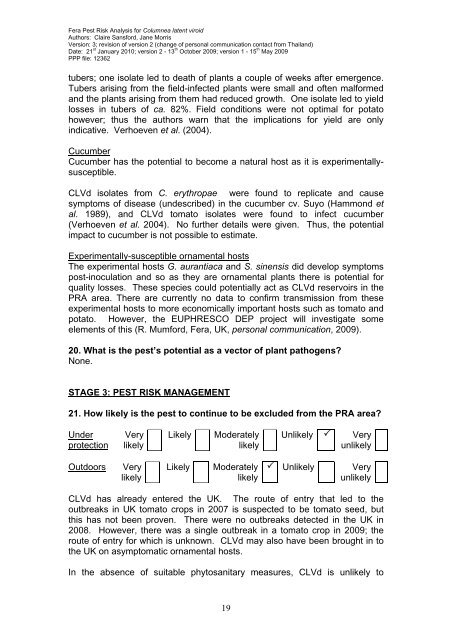Columnea latent viroid - The Food and Environment Research ...
Columnea latent viroid - The Food and Environment Research ...
Columnea latent viroid - The Food and Environment Research ...
Create successful ePaper yourself
Turn your PDF publications into a flip-book with our unique Google optimized e-Paper software.
Fera Pest Risk Analysis for <strong>Columnea</strong> <strong>latent</strong> <strong>viroid</strong><br />
Authors: Claire Sansford, Jane Morris<br />
Version: 3; revision of version 2 (change of personal communication contact from Thail<strong>and</strong>)<br />
Date: 21 st January 2010; version 2 - 13 th October 2009; version 1 - 15 th May 2009<br />
PPP file: 12362<br />
tubers; one isolate led to death of plants a couple of weeks after emergence.<br />
Tubers arising from the field-infected plants were small <strong>and</strong> often malformed<br />
<strong>and</strong> the plants arising from them had reduced growth. One isolate led to yield<br />
losses in tubers of ca. 82%. Field conditions were not optimal for potato<br />
however; thus the authors warn that the implications for yield are only<br />
indicative. Verhoeven et al. (2004).<br />
Cucumber<br />
Cucumber has the potential to become a natural host as it is experimentallysusceptible.<br />
CLVd isolates from C. erythropae were found to replicate <strong>and</strong> cause<br />
symptoms of disease (undescribed) in the cucumber cv. Suyo (Hammond et<br />
al. 1989), <strong>and</strong> CLVd tomato isolates were found to infect cucumber<br />
(Verhoeven et al. 2004). No further details were given. Thus, the potential<br />
impact to cucumber is not possible to estimate.<br />
Experimentally-susceptible ornamental hosts<br />
<strong>The</strong> experimental hosts G. aurantiaca <strong>and</strong> S. sinensis did develop symptoms<br />
post-inoculation <strong>and</strong> so as they are ornamental plants there is potential for<br />
quality losses. <strong>The</strong>se species could potentially act as CLVd reservoirs in the<br />
PRA area. <strong>The</strong>re are currently no data to confirm transmission from these<br />
experimental hosts to more economically important hosts such as tomato <strong>and</strong><br />
potato. However, the EUPHRESCO DEP project will investigate some<br />
elements of this (R. Mumford, Fera, UK, personal communication, 2009).<br />
20. What is the pest’s potential as a vector of plant pathogens?<br />
None.<br />
STAGE 3: PEST RISK MANAGEMENT<br />
21. How likely is the pest to continue to be excluded from the PRA area?<br />
Under<br />
protection<br />
Very<br />
likely<br />
Likely<br />
Moderately<br />
likely<br />
Unlikely Very<br />
unlikely<br />
Outdoors<br />
Very<br />
likely<br />
Likely<br />
Moderately<br />
likely<br />
Unlikely Very<br />
unlikely<br />
CLVd has already entered the UK. <strong>The</strong> route of entry that led to the<br />
outbreaks in UK tomato crops in 2007 is suspected to be tomato seed, but<br />
this has not been proven. <strong>The</strong>re were no outbreaks detected in the UK in<br />
2008. However, there was a single outbreak in a tomato crop in 2009; the<br />
route of entry for which is unknown. CLVd may also have been brought in to<br />
the UK on asymptomatic ornamental hosts.<br />
In the absence of suitable phytosanitary measures, CLVd is unlikely to<br />
19
















